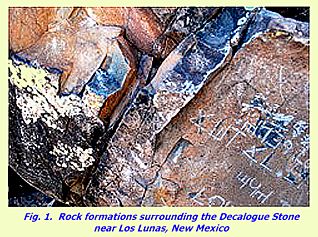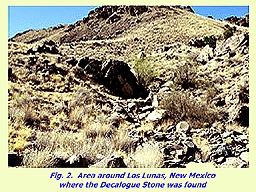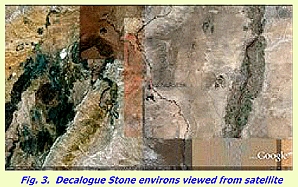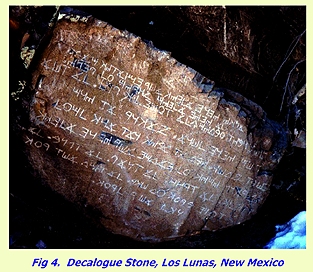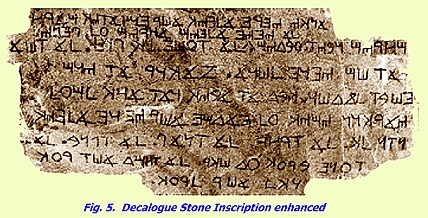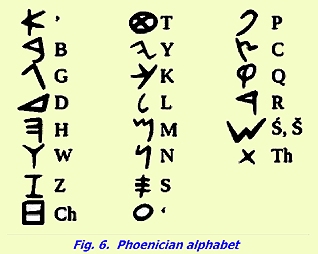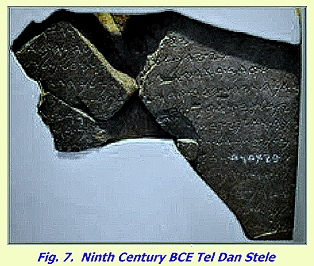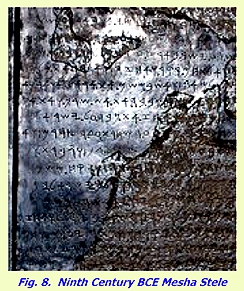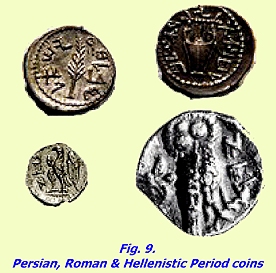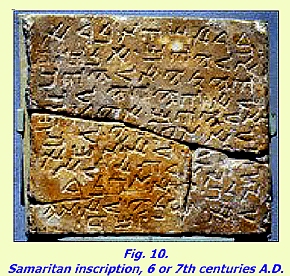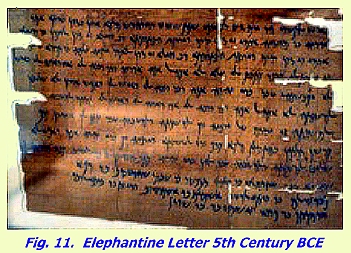Fichero: <Decalogue
Stone. htm> <Página
principal> <Índice> <Arqueología>
|
THE LOS LUNAS, NEW MEXICO DECALOGUE STONE (Contact) Following is a discussion of "The
Los Lunas Decalogue Stone: Genuine or Hoax?" by Mark
Perkins and Titus Kennedy
Please CLICK on Subjects and Numbered links for further
information: (Also see discussion of Mexico artifacts by
Franz
Tamayo)
In Dixie Perkins’s essay, “New Mexico’s
Mystery Stone,” she describes a stone inscribed in Ancient Near
Eastern languages, found in the desert west of Los Lunas, New Mexico 1. Intrigued by this Mark Perkins and Titus
Kennedy set out to locate what has become to be known as the Decalogue
Stone. It should be mentioned
at this juncture that a hieroglyphic inscription on leather in Mexico known
to Alexander Humboldt and subsequently analyzed by Franz
Tamayo bears the same message of The
Ten Commandments as the Decalogue Stone. However, the authors of The Los Lunas Decalogue Stone:
Genuine or Hoax?" either
were unaware of its existence or decided not to mention it. Their efforts to declare it as unauthentic
have taken precedence. The existence of
Pre-Columbian accounts of The Ten
Commandments in America is of course historically of the utmost
importance. Following the advice of local residents they
proceeded through ancient Native American sites and reached a place that
would have been no more than a temporary campsite en route to another
destination. 2 .
There they found a large boulder with its lower
portion chiseled flat and bearing nine lines of inscriptions. As they drew closer to the stone and
analyzed the inscription, it was apparent that the forms of the letters were
inconsistent. Some letters followed
Phoenician forms dating as far back as the 11th century B. C. E., while
other letters followed Samaritan forms as late as the 7th century A. D. , and
still others matched forms from ancient Greek script. As they further analyzed the surface of
the stone and the inscription itself, coupled with the history surrounding
it, their skepticism increased. The site turned out to be about
ten miles from the Rio Grande,
a navigable river in ancient times, and about a mile from a reliable source
of water, the Rio Puerco. A boundary mark that is not at a
prominent landmark or does not function as a prominent landmark itself is not
a good boundary mark. This location
would not serve as a good place for a rendezvous, either. No matter the century, the little arroyo
would be difficult to describe and more difficult to find. Fig. 3. CLICK to enlarge After an analysis of the stone and
several photographs, the two explorers began their return to Albuquerque
because it seemed there was little doubt that the stone was a hoax. Nevertheless, they wondered who might have
made the inscriptions. Was it the two
centuries old hoax of a Spanish Priest?
A converso Crypto-Jew who settled in the area during the colonial
period? While the settlement of
converts from Judaism to Catholicism who fled Spain to various countries
could have taken place in New Mexico as early as the 17th century, there was also
a migration of Ashkenazi Jews to New Mexico in the late 19th century. 3. The main problem with the Spanish Priest
and Crypto-Jew theories is that the majority of the letter forms used in the
inscription were not rediscovered until the late 19th century and early 20th century, which narrows
the time frame. Was it made by a
Mormon traveler to prove the archaeological veracity of the Book of Mormon? While possible, it is doubtful as the
inscription is not highly promoted by Mormon scholars, and one prominent
Mormon Brigham Young University
professor bluntly stated that it was faked. 4. Could it perhaps have been an early 20th century University of
New Mexico professor seeking credibility, or even an odd rancher from the
period who had some knowledge of ancient Hebrew and a keen interest in
ancient epigraphy? Only further
investigation could determine this. The stone was first recorded in
1936 by archaeologist Frank C. Hibben
of the University of New Mexico. 5. Hibben held a PhD in anthropology and was
a specialist in archaeology of the Southwest United States, focusing on
Native American cultures.
Unfortunately, Hibben was suspected of multiple fraudulent
archaeological activities during his career.
First, there was the Sandia Man
incident in which he was suspected of planting objects in the Sandia Cave to
support his thesis that there were people living in the area 25,000 years
ago. The thesis was not accepted,
although the evidence for his fraud on this matter is inconclusive. 6. The second incident occurred in Alaska
where Hibben claimed to have found a specific type of arrowhead matching
those of the Folsom culture in the High Plains region 10,000 years ago. This theory had no further support and
simply added to suspicions that Hibben sometimes made fraudulent
archaeological claims. 7. The third incident was the alleged
discovery of the Decalogue Stone. Hibben was the first to mention the stone,
and claimed that he was led there by a conveniently unnamed guide who found
it sometime in the 1880s. There is no
verifiable evidence to support Hibben’s claim, which is questionable based on
those three incidents and the accusations of forgery surrounding them. Other than a small, almost unknown
journal called Epigraphic Society Occasional Publications, only two well-known
scholars have published anything about the inscription. 8 . James Tabor of the University of North Carolina-Charlotte and Cyrus
Gordon of Brandeis University interacted
with the inscription. Tabor, a
conspiracy theorist who was behind archaeological and historical fantasies
such as the “Jesus Tomb” ossuaries
and the “Jonah” ossuary, both
which have been overwhelming rejected by scholars, interviewed Hibben about
the Decalogue Stone. He visited the site, and claimed that the
inscription was made by Israelites sometime in the B. C. E. era. 9 . He offered no detailed analysis of the
inscription and no plausible reason as to its antiquity other than the letter
forms. Cyrus Gordon theorized that
the Decalogue Stone was a Samaritan
mezuzah as part of an overall thesis that during Byzantine times, Samaritans
and others from the Near East dispersed all over the world, even to the
Americas. 10. Gordon, however, never saw the
stone in person and may not have looked closely enough at the Decalogue Stone to notice that it
could not be Samaritan.
First, a mezuzah contains the Shema (Deuteronomy 6:4-9),
and the Vehaya (Deuteronomy 11:13-21)
rather than a full version of the Ten Commandments. 11 Second, the Samaritan version
of the Ten Commandments is markedly different than the version found in the
Dead Sea Scrolls, LXX (Greek Old Testament), and Masoretic texts (Hebrew Old Testament). The Samaritan version says
“preserve” rather than “remember” the Sabbath day, in addition to the
Samaritan expansion that includes a command to build the temple on Mount
Gerizim. These Samaritan elements are
missing from the stone, which instead follows the Masoretic text almost
letter for letter except for a few spelling errors. And, of course there is the problem that the inscription is not
written in a homogenous Samaritan script, or even the Hebrew square script,
which most Hebrew language inscriptions used during the Byzantine Period. Fig. 4. CLICK to enlarge The Los Lunas Decalogue Stone, first made known to
the public in 1936,12 is a carving of 9 lines of text onto a
large, flattened basalt surface connected to a massive boulder. The language of the inscription is Hebrew,
and a translation of the text reveals that the inscription gives a summary
form of the Ten Commandments from the Masoretic text of Exodus 20:2-17. The number of characters per line from
top to bottom is as follows: 28, 21, 28, 21, 28, 29, 25, 25, 10. The first 3 lines are extremely close
together, almost touching, while the final 6 have a space of about a letters
length in between each line. This is
due either to a blatant error that will be discussed later, or to an
adjustment by the inscriber so that the text would better fill the rock face.
The spacing between words and
letters is somewhat inconsistent, although not to the point where it presents
difficulty in discerning one word from another. The letters themselves are fairly uniform, but do reveal it was
not a practiced hand that wrote them.
The form of the script is not homogenous—the author employed several
scripts that are from several different time periods and at least two
distinct languages (this will be discussed later). Looking at the stone and examining the form of the inscription,
it is apparent that a scribe was not the author and the inscription was not
well planned out. (Compare with a probable
earlier artifact from México studied by Alexander von Humboldt) A
decipherment and translation of the stone follows: (3=alef [ א], ‘=ayin [ ע], $=shin [ ש],
x=het [ ח], c=tsade [ ([צ 1) 3nky yhwh 3lhyk 3$r
hwc3tyk m3rc אנכי יהוה
אלהיכ אשר
הוצאתיך
מארצ I am YHWH your God who
brought you out of the land 2) l3 yhyh 3lhym 3xrym
‘l phny לא יהוה
אלהים אחרים
על פהני You will not have other
gods before [spelling error] Me 3) mcrym mbyt ‘bdym
-> l3 t’$h lk psl l3 t$3 מצרים
מבית עבדים
לא תעשה לך
פסל לא תשא Of Egypt from the house
of slavery -> You will not make for yourself an idol. You will not take 4) 3t $m yhwh l$w3. z3kwr 3t ywm את שם יהוה לשוא זאכור את יום 5) h$btm lqd$w. kbd 3t 3byk w3t 3mk lm’l השבתם לקדשו כבד את אביך ואת אמך למעל Of the rest (shabbat)
to keep it holy. Honor your father
and your mother in order that [spelling error] 6) y3rkwn ymyk ‘l h3dmh
3$r yhwh 3lhyk יארכון
ימיך על
האדמה אשר
יהוה אלהיך Your days may be prolonged
upon the land which YHWH your God 7) Ntn lk. L3 trcx.
L3 tn3p. L3 tgnb. L3 נתן לך לא
תרצח לא תנאף
לא תגנב לא Gave to you. You will not murder. You will not commit adultery. You will not steal. Not 8) T’nh br’k ‘d
$kr. L3 txmd 3$t r’k. תענה ברעך עד שכר לא תחמד אשת רעך You will (not) answer
deceptively [spelling error] against your neighbor. You will not covet the wife of your neighbor. 9) Wkl a$r lr’k. וכל אשר
לרעך Or anything, which
belongs to your neighbor. Fig. 5. CLICK to enlarge CLICK to enlarge The Inscription Characteristics The inscription, while often
thought to be written in “Paleo Hebrew,” or “Phoenician”, is actually a
mixture of multiple Semitic scripts with a few Greek characters. 13,14,15,16,17 Fig. 6. CLICK to enlarge For anyone familiar with Semitic
inscriptions, a first look at this inscription immediately gives the
impression that it is a poor forgery because it is not comparable to any
other Semitic inscription discovered.
This is due not only to the odd mixture of scripts, but also because
of the appearance of the characters themselves. Yet, if this inscription was made in the late 19th or early 20th century, near the time
of its 1936 discovery, the mixture of letters may be explained by the lack of
extensive knowledge about the Phoenician script. The Phoenician script was
re-discovered in 1855, and a transcription and translation from the
Phoenician sarcophagus of Eshmunazar II at a site near Sidon was published in
the June 15, 1855 New York Times, while a facsimile of the inscription
itself was published in the July 1855 edition of United States Magazine. Other scripts present in the inscription
were known at least by the end of the first decade of the 20th century. Alternatively, the mixture of letters may
be explained by the inscriber’s purposeful intent to create a more mysterious
inscription. The extensive assortment
of character forms is certainly unique and draws interest to the inscription
on those grounds alone.
The following evaluation of the characters present in the inscription
was done by means of comparing numerous photographs, drawings, and charts. 18 In general, the
letterforms on the Decalogue
Stone resemble the Phoenician
script and its immediate descendents, with a few replacements and
modifications, notably archaic Greek 19 This use of a modified Phoenician script
suggests the inscriber was attempting to emulate stone inscriptions from the
Iron Age, at least partially.
However, an obvious general form disagreement can be seen between the Decalogue Stone and ancient
inscriptions written with the Phoenician alphabet—the variance in the slope
of the letters. On the Decalogue Stone, the backs of the
letters that have a horizontal line are aligned straight up and down at a
90-degree angle to the line. In
contrast, the backs of many letters with horizontal line are written at a
sloping angle in ancient Semitic inscriptions written in the Phoenician
script, while letters in ancient Greek inscriptions are characteristically
straight. 20 Additionally,
inscriptions using the Phoenician alphabet from the Iron Age also have long
tails on many of the letters, which the letters of the Decalogue Stone lack. On the Decalogue Stone, the form of the
letters Alef, Bet, Gimel,, Nun, Ayin, Peh, and possibly Kaf and Waw could be
assigned to the Phoenician script, also used for archaic or paleo-Hebrew
(roughly 11th
to
6th
century
B. C. E.), although this would not be the hand of a trained and experienced
scribe. 21. The letter Heh follows a form from
the Roman period found on coins from the area of Judah between the Persian
and Early Roman Periods (4th century B. C. E. through the 2nd century A. D. 22. Fig. 9. CLICK to enlarge The letter Waw is somewhat similar
to the Phoenician, but more square and thus similar to Old Aramaic forms. 23. The letter Zayin is one of the characters
that appears to be borrowed from the Zeta used in some ancient Greek
inscriptions stretching from the Archaic through the Byzantine period. 24. The letter Het looks identical to the
Greek Eta used in inscriptions from a variety of periods. Tet is not present in the inscription, and
cannot be commented on. Yod clearly
follows a Samaritan form, although with more angular strokes and without a
slope. 25. Fig. 10. CLICK to enlarge Kaf and Lamed appear to follow the
Kappa and Lambda from ancient Greek inscriptions, but reversed, although the
Kaf presented on the stone could be interpreted as a Phoenician form that
changed its orientation from slanted to straight up and down. Mem is yet another Samaritan form, but simplified
without the addition to the tail veering left. 26. Samek appears only once, but follows a
Hebrew form from Egypt, such as would be used in the 5th century B. C. E. . Elephantine Letters, or alternatively a backwards
Tsade from Phoenician inscriptions. 27. Fig. 11. CLICK to enlarge The letter Peh, as mentioned
earlier, could be classed as Phoenician or Archaic Hebrew, but also matches
Old Aramaic forms. Tsade is the
latest represented form, appearing to be Rabbinical or Rashi script type for the
final form of Tsade from the mid-second millennium A. D., but could also be
construed as a strange variant of an Aramaic form. 28. Qof is only represented once, and matches
a form from Proto-Sinaitic and Proto-Canaanite inscriptions (ca. 1500-1100 B. C. E. ), although it could
also be a corrupted version of a Samaritan Qof used in inscriptions. 29. Resh is written in the same form
as Hebrew during the Roman period as well as a Samaritan script Resh, but
could also be interpreted as a Greek Rho, reversed, much like the Kappa
present in the inscription, so this letter is a poor indicator. Shin follows the Samaritan form, but also
resembles the Omega from Greek inscriptions in the Byzantine Period. Finally, Taw is yet another letter adopted
from a wide range of Greek inscriptions.
Thus, it is apparent that the author of the inscription used an
extremely wide range of letter forms, only excluding, probably deliberately,
the commonly known square script used for Modern and Biblical Hebrew today,
which dates back in an earlier form to the Aramaic square script and began to
be used for Hebrew during the period of the Babylonian Exile. The inscriber, however, may not
have known ancient alternatives to the modern day Hebrew square script for 4
or 5 of the forms (Tet is not present, which could have been the sixth, and
Kaf is debatable), as evidenced by the adoption of either Greek script or
simply inventing a letter form that looked similar to other ancient forms
used to write Hebrew. This suggests
an incomplete knowledge of the ancient Phoenician or Archaic Hebrew script,
making substitution of other ancient forms necessary, while clearly making a
point to leave out forms that are used in modern day Hebrew. Another possibility is that the
author of the inscription intentionally mixed the Greek script forms to give
the text a more unique and puzzling character. The mixing of diverse letter forms from multiple periods,
regions, and languages is simply unprecedented for any ancient monumental
inscription. This alone argues
strongly against the authenticity of the Decalogue Stone. The final important point to remember is
that all of these letter forms used were known prior to 1936, with the latest
significant script discoveries more than 20 years before the Decalogue Stone was recorded by Hibben
30.
The inscription could certainly have been
forged, with these letterforms, by 1930 or slightly earlier. An analysis of the text reveals
some interesting features. The most
obvious is the scribal error in line 3, which is an added continuation of
line 1 and marked by an upward pointing correction arrow. The author apparently noticed after finishing
line 2 that the end of the clause from line 1 had not been completed, and so
inserted it before beginning the third sentence, along with an arrow mark
facing upwards, indicating that it should be read with a higher line. 31. Line 1 ended with a word starting with
Mem, and the next word also began with a Mem. After the first sentence, nearly all of the clauses began with
a Lamed. The inscriber could have
thought he already copied the next 3 words and simply skipped that line, only
to realize later and insert a correction.
Regardless, what this error clearly indicates is that the author of
the inscription was not familiar with Hebrew, and especially not the ancient
letterforms. The error also indicates that the
scribe was copying from a source taken to the site and not from memory. The act of stopping mid-sentence and
beginning a new one demonstrates that what was being done was simply letter
for letter and sound for sound copying.
No actual scribe would do this, as scribes are literate in the
language or languages in which they write, and would usually write out the
inscription beforehand to avoid mistakes of this nature. The last and possibly most
important aspect of this error is the presence of the upward pointing
correction arrow in the actual inscription.
This use of a correction arrow is unprecedented in ancient Semitic
inscriptions. In ancient Egypt there
were cases of scratching out a former Pharaoh’s name and replacing it with
another, but this is a completely different situation, and no use of any
correction marker was used. This
correction arrow indicates a composition of the inscription outside of
antiquity, and suggests composition in the time of typeset or typewriters,
certainly fitting of an early 20th century professor.
The case for a combination of both
a copying error and limited familiarity with Hebrew can be made when various
misspelled words are analyzed. For
example, the last word in line 2, copied as phny, adds a Heh to the
word. If the copyist had just read
the word off the Masoretic text, or simply had a transcriptional copy of the
9 lines to be inscribed, an error from vocalization to writing would be
easily explained. Reading pa-nay and
then thinking out the sounds could easily translate into writing
pah-nay. Another error like this
occurs in line 4, when “zakor” is written with an Alef following the
Zayin. If reading a transcription of
the Masoretic text, or even the vowel pointed Masoretic text, it would be
easy accidentally to insert a “vowel” in the form of Alef into the word if
the copyist’s native language writes vowels.
In line 5, lema’an is written as lema’al, indicating a misreading of
the final Nun for a Lamed. While
lema’an means “in order that,” a very common word, and is found in the
commandment in Exodus 20:12, lema’al is nonsense and is an obvious
error. This error likely arose from
the inscribers misreading of final Nun in the Masoretic text for a Lamed,
since the forms are similar in the modern square script, but Nun and Lamed in
the Phoenician script are quite distinct. In line 8, Shaqer is written
Shkr—a confusion of the Kaf and Qof.
For a non-Hebrew speaker, this is an easy error to make when copying
and thinking of the sounds while inscribing.
This error also suggests the possibility that the Masoretic Hebrew
text was first transcribed into Latin characters, then reproduced in the
various scripts present on the stone. The analysis indicates that the
text was simply transferred from the Masoretic text, in incomplete form, into
ancient letter forms with little preparation and care. It further indicates that the author did
not have a good understanding of Hebrew, if any beyond knowing sounds for the
letters. Finally, although Barry Fell
claims in his article about the Decalogue Stone that the punctuation
matches that of ancient inscriptions, his conclusion is incorrect. 32. Examining ancient Semitic inscriptions
such as the Tel Dan Stele or the Mesha Stele shows that the alleged
“punctuation” marks present in Semitic inscriptions are actually word
dividers, not “periods. ” These dots at the bottom of the line in the Decalogue Stone also hold a different
position from the word divider dots in the middle of the line for Semitic
inscriptions. Instead, the Decalogue Stone uses modern
punctuation methods by placing periods at the end of sentences, which further
indicates its modern composition. Concerning the method of
inscription, patina, and angle of the stone, little can be said. Any definitive clues as to the age that
would be indicated by patina have been wiped away because of exposure to the
weather and the thousands of visitors that have touched, tampered with, and
even vandalized the stone (line 1 has been nearly scratched out). The appearance of the inscription looks
recent, but this evaluation cannot be used as primary evidence that the
inscription is from the recent past because of the conditions under which the
inscription has been subjected. The inscription rests at a strange
angle on “a boulder weighing an estimated 80 to 100 tons and is about eight
meters in length. Nine rows of 216
characters were chiseled at a 150 degree angle into the north face,” although
the ground at the base of the stone is quite flat. 33. Either the entire boulder has shifted
over time, the inscriber wrote it at that angle because it would give the
appearance of age, or because of the convenient shape of the rock section
where the inscription was placed, the inscriber decided it would look best
lining up with the square shape of the rock section. The method of the inscription
appears to be use of a chisel for the letters themselves. A small chisel, tapped lightly or even
used to scrape at times, would be the most likely method judging from the
short depth of the incisions into the rock.
No true round shapes, though prolific amounts of extremely angular shapes
are found indicate a somewhat large tool and an unpracticed hand. However, the method used to
flatten the surface before the inscription is perhaps the most interesting
physical aspect of the Los Lunas Decalogue Stone. Judging from the depth of the cuts into
the stone, at least two inches at some points, and the stress lines left from
this chipping away, a very large and strong tool must have been used for this
process. The stress fracture lines created
by creating a flat rock surface are generally at least two inches apart. The stone, basalt, is quite strong. It might be that a chisel made with a
strong metal such as iron or steel, along with a large hammer, or possibly
even a sledgehammer with a triangular point, made for breaking rocks, was
used for creating a flatter surface on which to write. These tools are fairly modern, and would
have been the tools of choice in the early 20th century when the
inscription was first seen. The above evaluation of the Los Lunas
Decalogue Stone suggests that it was
not composed by a professional scribe in antiquity, but (a) composed by
someone with a limited or no knowledge of Hebrew, (b) who did not follow the
form of any other known ancient Semitic inscription, (c) who positioned the
stone in an implausible location for a monumental inscription; further, (d)
the inscription was written after the rediscovery of the Phoenician script in
the late 19th
century,
and (e) was made with modern tools.
Even more, (f) the initial discoverer of the inscription, Frank
Hibben, had a questionable reputation because of at least three incidents in
his career in which he claimed to have made radical discoveries that had no
supporting evidence. Hibben also was
not a specialist in Semitics or the Ancient Near East, but conveniently lived
nearby as a professor of archaeology at the University of New Mexico. Thus, the evidence leads to the conclusion
that the Decalogue Stone is a creation of the
late 19th
or
early 20th
century
by someone aware of the Mexican hieroglyphics
depicting The Ten Commandments. |
|
Footnotes: (All Photos enhanced and sharpened from originals) Titus Kennedy earned a B. A. from Biola University, M. A. from the University
of Toronto in Near Eastern Archaeology, M. A. and in Biblical
Archaeology from the University of South
Africa. He is pursuing a Doctorate in Biblical
Archaeology at the University of South
Africa. You may reach
Titus at titusm@gmail. com. Mark
R. Perkins earned a B. A. from Azusa Pacific University and M.
Div. from Talbot School of
Theology. He is pastor of
the Front Range Bible Church in
Denver, CO. You may reach Pastor Mark
at frontrangepastor@gmail. com. 1. Perkins, Dixie L. “New Mexico’s Mystery Stone,” Best of the West, Tony Hillerman,
ed. 1991 (New York: Harper Collins),
3-5. 2. Dawson,
Jerry and Judge, William J.
“Paleo-Indian Sites and Topography in the Middle Rio Grande Valley of
New Mexico,”The Plains Anthropologist 14:44
(1969): 149-163. 3. Carroll,
Michael P. “The Debate over
a Crypto-Jewish Presence in New Mexico: The Role of Ethnographic Allegory and
Orientalism,” Sociology of Religion 63:1
(2002): 1-19; 2, 8-9. 4.
Nibley, Hugh W. Teachings of the Book of Mormon, Semester
2, Lecture 30, Mosiah 6. Maxwell
Institute, Provo, Utah, 1988-90. 5.
http://www.
nmstatelands. org/Permits. aspx. Hibben graduated from Princeton in 1933, and
then in 1936 received a master’s degree in zoology from the University of New
Mexico, firmly placing him in the area in 1936. 6.
Bliss (1940a). “A Chronological Problem Presented by
Sandia Cave, New Mexico. ” American
Antiquity (Society for American Archaeology) 5 (3): 200–201. 7.
Nature
426 (27 November 2003) 374. 8. The Epigraphic Society
is a club of amateur epigraphers who occasionally publish collections of
papers. It was founded in 1974,
primarily by marine biologist Barry Fell. 9. Tabor, James D. “An Ancient Hebrew Inscription in New
Mexico: Fact or Fraud?” United Israel
Bulletin Vol. 52, Summer
1997, 1-3. 10. Gordon, Cyrus,
“Diffusion of Near East Culture in Antiquity and in Byzantine Times,” Orient 30-31 (1995), 69-81. 11. The Shema is so named because it begins with
the Hebrew command “Hear!” The Vehaya begins
with the Hebrew phrase “And it will be. ” Both passages are an important part
of Jewish and Samaritan prayer. 12.
http://www. nmstatelands.
org/Permits. aspx.
Although there are claims that Hibben discovered the inscription in
1933, the first documented discovery is 1936. The name of YHWH for
nothingness (in vain). Remember
[spelling error] the day. 13. http://www. nmstatelands.
org/default. aspx?PageID=127.
Accessed August 17, 2009 14.
http://www. ancient-hebrew.
org/15_loslunas. html.
Accessed August 17, 2009 15.
http://en. wikipedia.
org/wiki/Los_Lunas_Decalogue_Stone Accessed August
17, 2009 16.
Deal, David Allen, Discovery
of Ancient America, 1st ed. , Kherem La Yah Press, Irvine CA,
1984; 3-4. 17.
http://www. econ. ohio-state.
edu/jhm/arch/loslunas. html. 18. The included photos show
some comparisons of letter forms discussed.
For general guidelines on analyzing inscriptions; cf. Demsky, Aaron. Reading Northwest Semitic Inscriptions. Near
Eastern Archaeology 70:2 (2007), 68-74. 19. Healy, John F. Reading
the Past: The Early Alphabet.
Berkeley: University of California, 1990; 29, 37. 20. Cf. stone inscriptions as the Ahiram
Sarcophagus, Sarcophagus of Eshmunazar II, Tel Dan Stele, Mesha Stele, and
Siloam Inscription. 21. Cf. The Ahiram Sarcophagus, the Gezer
Calendar, the Tel Dan Stele, the Mesha Stele, the Siloam Inscription, the
Shebna Lintel, the Ekron Inscription, the Stele of Zakkur, and others from
the Iron Age. 22. Cf. especially the Yehud coins, but also
Hasmonean and Judean revolt coins. 23.
Mykytiuk, Lawrence
J. Identifying
Biblical Persons in Northwest Semitic Inscriptions of 1200-539 B. C. E. .
E. Boston: Brill,
2004. Fig. 8, 114. 24.
The Greek Zeta sometimes
varied in form, but the most common form in inscriptions across all
time-periods resembles that on the Decalogue
Stone, which is also the same form as modern Greek. 25.
The stone inscription of
the Samaritan Ten Commandments from the Byzantine or early Islamic Period,
housed in the Living Torah Museum, or the Samaritan Mezuzah inscriptions from
the 6th to 7th
centuries AD, are excellent comparisons. 26.
Again, cf. the Samaritan above referenced Samaritan
inscriptions. 27.
Although this is not a
stone inscription, it was the closest parallel found. Alternatively, the possibility of the
letter being crafted after backwards Tsade could indicate another mistake by
the inscriber. 28.
Lidzbarski, Mark, Letter
Chart in Appendix to Gesenius, H. F. W.
Genesius’ Hebrew Grammar. Oxford, 1922. ; Healy, 29. 29.
Naveh, Joseph. “Some Considerations on the Ostracon from
‘Izbet Sartah. ” Israel Exploration
Journal 28:31-35.
Fig. 1, 31. 30.
Torrey, Charles C. (1925), “The Newly Discovered Phoenician
Inscription,” New York Times, June
15, 1855, 4. “The Ahiram Inscription of Byblos,” Journal of the American Oriental Society, 45:269–279. Dussaud, René, Syria 5 (1924:135-57). 31.
This phenomenon could be
due to a scribal error such as homeoarchy or haplography. 32. Fell,
Barry; “Ancient Punctuation and the Los Lunas Text,” Epigraphic Society, Occasional Publications, 13:35, 1985. 33. http://www. nmstatelands. org/default. aspx?PageID=127.
Accessed August 17, 2009. |
